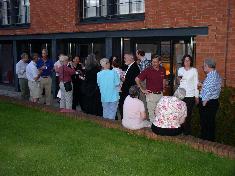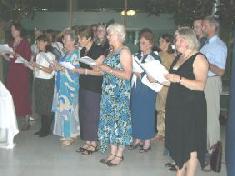Conference 2006: Meeting New Challenges
Page owner: Conference director
Reports from the 2006 SfEP conference at the University of Nottingham's Jubilee Campus
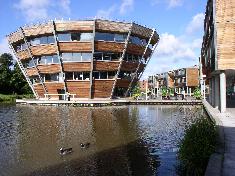
Jubilee Campus, Nottingham University
(click image to enlarge) © SfEP
- Whitcombe Lecture: Ian Ritchie
- Truly professional: John Button, Bookcraft
- Email marketing: Susan Hallam
- The best mouse-trap in the world?: Paul Elliott, Business Link
Workshops and seminars
- Working with macros and Visual Basic: Anne Waddingham
- Using internet resources: Rod Cuff
- Working with PDFs: Kathleen Lyle
- Rewriting: Chris Lindop
- English into English: Josephine Bacon
- Conference diary: Anne Waddingham
These edited articles first appeared in the conference supplement of the November/December 2006 issue of Editing Matters.
Whitcombe Lecture: Towards the information appliance
Ian Ritchie
Reported by Ros Morley
Ian Ritchie CBE has an impressive CV. Not least among his achievements is that he acts as a business angel, providing support and advice for numerous start-up companies in the technology sector.
'The successful entrepreneur needs to be aware of the marketplace,' he says. 'Unless you've got customers, you haven't got a business.'
And yet his talk wasn't about setting up a business. Or was it?
The Manchester Baby
We were treated to the fascinating history of the information machine, starting with the Enigma cipher machine – how the machine worked, how the workers at Bletchley broke the code. We heard about the 'Manchester Baby', the world's first electronic digital computer, so called because it was designed and built in 1948 at Manchester University.
The most intriguing part of Ian Ritchie's presentation led on from the essay 'As We May Think' published in Life Magazine in 1945. The author was Vannevar Bush, who predicted a memex machine, or thinking machine, which would become a vast library with new forms of encyclopedias, based on microfilm.
And so Ian Ritchie led us through the many people who followed on – Ted Nelson and Douglas Engelbart, who invented a technology similar to that which we now call hypertext.
Petabytes and exabytes
The next person on the scene was Tim Berners-Lee, whose parents had both worked on Manchester Mark I (which followed the Manchester Baby) at Manchester University. Berners-Lee, while working at CERN in Switzerland, carried out experiments with hypertext and built a prototype system called ENQUIRE, which contained many features of the World Wide Web, but was more closely allied to the Wiki format.
We then heard about the modern computer, the WWW as a publishing medium, Google search and find, and how, in about 2025, the computer system will be a big as it will ever need to be for individuals. Yes, I knew all about megabytes (MB), gigabytes (GB) and terabytes (TB) for data storage capacity, but not petabytes (PB) or exabytes (EB). The latter is one quintillion bytes (1,000,000,000,000,000,000 - or 10^18 - bytes).
Making money
Ian Ritchie's lecture ended with examples of publishers inviting comments on the web, shared databases, instant messaging, forums, blogs and wikis, which is where we as editors enter the scene. We're all familiar with web editing even if it isn't an area of work we offer, and of course, we're concerned when we find bad editing or unedited texts on the web. But forums, blogs and wikis – how do we incorporate these into our work – or to put it bluntly, how do we make money out of them?
I was glad that I knew what blogs and wikis referred to – until about three years ago, I'd probably have thought blog was a swear word. Then a client asked me (fortunately by email) if a blog was public domain. A quick internet search led me in the right direction and I was able to give a prompt reply – it depends!
Setting up a wiki
For me, the Whitcombe Lecture was an interesting and informative history of the information machine, and most of it was new to me – I have to admit to not knowing of Vannevar Bush, the memex machine, Ted Nelson, Douglas Engelbart or Tim Berners-Lee. And, of course, I know all about the Wikipedia – and have used it many times.
I wouldn't have known how to set up a wiki, and I don't suppose I'll ever need to know. But judging by the interest in the question-and-answer session, quite a number among us are already active in this area.
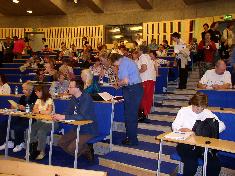
Delegates relax in the lecture
theatre in between presentations
(click on image to enlarge it)
Truly professional: The T-factor
John Button, Bookcraft
Reported by Melanie Thompson
Do you answer the phone while still in your pyjamas? Do you on-screen edit while tucked up in bed with your laptop on your knee? Do you send back proofs in tatty re-used envelopes, taking care to make sure there are plenty of biscuit crumbs enclosed to shower the client's desk?
I'm sure that none of our SfEP members would ever do any such thing. After all, we're all 'truly professional' … aren't we?
But is being 'truly professional' really as simple as remembering to get dressed, being wary of the dangers of RSI (and bed-sores), or taking care of basic hygiene?
Hermits and recluses
John Button, director of Bookcraft, took to the stage at September's 'National Conference of Hermits and Recluses (and Pedants)' – also known as the SfEP conference – to give us all his take on this thorny topic.
First, the definitions. We all have a vague idea of the differences between amateurs and professionals (admittedly, mainly based on sporting activities). John defines a professional as 'someone who is doing it for money – a real job, of real value, for real money'. But what about the 'truly'? Well, that took him some 40 minutes to define. Along the way, he told a few cautionary tales, and gave some excellent pointers on how we can all get the 'T-factor'.
So, pens at the ready (you do have your pen handy, surely?), here's a whistle-stop tour of the T-factor.
The true professional:
- knows what the client is paying for
- knows what's appropriate for the project and balances 'standards' with what is achievable/acceptable in the 'real world'
- keeps up with the latest developments and is prepared to go beyond their 'comfort zone'
- knows what really matters … and what doesn't
- knows what is not needed, and then doesn't do it (!) – i.e. knows their limits
- asks for help when needed (thank goodness for SfEPline)
- knows 'what sort of help helps' and delegates tasks when necessary.
The true professional remembers the importance of communication. In general, standards in this are so poor that it's relatively easy to be better than the competition. You won't go far wrong if you:
- communicate with others in the way you wish them to communicate with you, especially by email (think: 'Would it be OK to go back to this email in two years' time?')
- always give clear instructions and play back to your client what you think they have asked you to do
- don't make assumptions, but do propose solutions.
Contactability
So far, so fantastic. But then John raised the issue of 'contactability', and here I have to disagree with him. He is a self-confessed Blackberry addict. (Me, I'm a strawberries fan.) He admits to checking his emails regularly while away on vacation, and takes the 'one call or you're out' approach to phoning freelancers to place work. I think that's a bit tough.
Many of us are freelancers so that our work fits in with other aspects of our lives – I don't think it would be 'truly' professional to answer my mobile while I'm standing on the touchline surrounded by screaming seven-year-olds whose team has just scored. Leave me a message and I will call you back as soon as I can … I promise.
Ah, but there I do agree with John. For goodness' sake, people, please do make sure that your answering-device-of-choice states your name clearly, followed by a polite 'I will call you back' – not the anonymous 'call minder' option, and not a whole-family-sing-along either!
Listening to your inner voice
John gave conference numerous other gems to ponder:
- 'You won't get everything right. Sometimes it will be your fault.'
- 'It always pays to hone your technical skills.'
- 'Listen to your inner voice.'
- 'Assess a project as soon as it arrives, even if you don't need to work on it for several weeks.'
- 'I don't believe in a "light edit". I do believe in a "heavy proofread".'
- 'Remember: you're not working for a "higher good"; you're working for the client.'
- 'The client almost always has more need to be right than you do.'
- 'I know I'm right, but I don't need to be.'
And finally … the mark of the 'true' professional is that 'We take it seriously; we think it matters; and we know why it matters.'
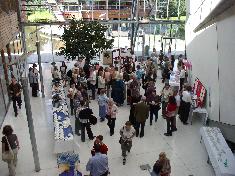
Delegates meet for coffee
and chat in the Atrium
(click on image to enlarge it)
Email marketing
Susan Hallam
Reported by Mary Brailey
Dynamic e-business guru Susan Hallam challenged our scepticism about the ethics and effectiveness of email marketing, debunked some of the myths around it and gave us a whistle-stop tutorial of how to venture into this form of marketing.
Some key facts about the curse of 'spam': 84% of email messages are unwanted [a percentage that has risen sharply since Susan's talk], people only open and read (or, mostly, merely scan) a third of their email. But conventional mail shots are expensive, and their results can't be quantified, so there are good reasons to consider doing some email marketing.
Susan contends that email marketing, done well, benefits both us and our clients. We can use it to retain existing clients, find new ones, keep in touch with people and obtain immediate responses.
Having made her pitch in favour of email marketing, Susan proceeded to explain how to tackle it:
- Set objectives: for instance, to retain clients or generate interest in particular services.
- Consolidate existing data: collate the contact information most of us keep unsystematically in our email address book, elsewhere on our computer, and in address books and files.
- Understand the legal situation: For instance, it is legal to send unsolicited emails to businesses but not to individuals. We can send people invitations to subscribe to our 'e-newsletter': they have to positively opt in, though, and every issue must include an 'unsubscribe' option. By issuing a newsletter, say, twice a year, we can remind subscribers that we exist and tell them about our projects or any new services. You can also rent an email list - for a single mail shot or for a period of months - from about 10p per name.
- Write effective content: The 'From' field should have a clear 'brand', the 'Subject' field should be arresting and short enough to fit in the 'window' (max. 35 characters), and the text should be designed to be scanned rather than read. Avoiding words like 'best' or 'free' (especially in large mailings) reduces the chance of being identified as spam, and in case the sending address gets blocked as a 'spammer', it is best not to use your usual email address. Some personalisation - but not too much - can be useful: for instance addressing the recipient by name (but see delivery mechanism below).
- Plan the design: Email marketing templates are available free on the internet. HTML is considered to be a more successful format provided it looks like plain text, which people feel is more 'trustworthy': it is best to send both HTML and text versions so the recipient can choose.
- Choose the right delivery mechanism: Outlook and other common email applications can neither personalise mass emails for each recipient nor give good information about how recipients deal with your message. This requires software such as Ganymede or Constant Contact.
- Deal well with responses: For example, select a relevant page on your website as a 'landing page' for recipients clicking through from your email. Reply to 'unsubscribers', thanking them for their interest and enquiring (gently) why they are 'unsubscribing'.
- Monitor what people do with your email: Specialist email software will provide details of the recipients who have bounced, unsubscribed, clicked, opened or not responded at all to your email, so that you can refine your marketing to particular groups or types of recipients.
The presentation led to a flurry of questions from the audience, mostly on the subject of blogs (web logs) – a hot topic on SfEPLine recently. Susan considered professional (not personal) blogs to be very effective if done well: Google and other search engines are attracted to blogs because they generate constantly changing content on the web page. They also have an advantage over emails because they are not caught by spam filters.
You can download Susan's email marketing checklist (100KB PDF) from her website.
So – how come they don't know you have the best mouse-trap in the world?
Paul Elliott, Business Link
Reported by Gerard Hill
If a man make a better mouse-trap … tho' he build his house in the woods, the world will make a beaten path to his door.
Ralph Waldo Emerson
But how will the world know about you? How will they know about your mouse-trap? And how will they find your door? These were the questions that Paul Elliott of Business Link set out to answer, and not just for men in woods (and tights).
He began, with apologies to Carlsberg, by screening the slogan:
Probably the finest editors and proofreaders in the world
– but, he asked, how many people knew we were? We knew this would be a lively session when he made everyone stand up. If only 10 people knew how good we were, we sat down. Only 20 people? Many more sat down. Few of us, it seemed, had told over 30 people about our extraordinary talents.
We need marketing – reaching potential clients. We need promotion – getting our message(s) across – and the best promotion is word-of-mouth referral, so collect recommendations from clients. We can use websites, directory entries and business cards, but Paul's message was: We need to get out more, meet people and network.
You can network anywhere – using the photocopier, waiting for a train, at the pub, even in the playground – but you'll need an 'elevator pitch'. Actually, Paul's screenshot said 'escalator pitch', which is the same, only slower (unless you are going opposite ways, when it has to be a whole lot quicker). If you're British, it's a 'lift line', I suppose.
In no more than 12 words, your 'lift line' hooks the potential client, tells them what you do and makes them want to know more. Follow it up. The worst they can do is say no. Be bold! Don't be a mouse; build a better trap.
Workshops and Seminars
Working with macros and Visual Basic for Applications (VBA)
Anne Waddingham
Reported by Susan Faircloth
Anne Waddingham, ably assisted by Kathleen Lyle, led this workshop. Anne specializes in on-screen editing, and teaches various courses for SfEP and the Publishing Training Centre.
The workshop gave us an opportunity to extend our knowledge of macros, using VBA (Microsoft's programming language, currently in its seventh version). Anne's brief introduction stressed the value of using VBA to make macros work more efficiently and to enable users to learn new skills, which they can then offer their clients. This was followed by hands-on exercises that included:
- creating, combining and extending macros
- removing redundant code from combined macros, to enable faster running
- 'stepping through a macro' – i.e. going through it line by line – which is useful for 'debugging'
- using the Organizer to work with a macro (for copying, renaming or deleting)
- using the VBA editor to insert a new module and rename it (a 'module' is a collection of macros, and 'modules' are collected into a 'project').
This workshop exemplified the conference theme of meeting new challenges. For some, like me, there were moments of puzzlement, but with patient assistance from Anne and Kathleen, we were soon back on track.
In summarizing, Anne drew our attention to some of Woody's Tips (helpfully collected and published by the author Woody Leonhard in bulletins and in book form) – in particular, the need to go slowly, be observant, experiment, keep software up to date and, above all, to keep a sense of humour.
Using internet resources
Rod Cuff
Reported by Ben Harris
It was Francis Bacon who is said to have identified 'busy workshops' as one of the three ingredients for prosperity. On that basis, the future looks bright for the membership of SfEP.
Using internet resources, led by Rod Cuff, would surely have been top priority for any modern-day Bacon, opening up a host of new ways into the vast ocean of public and private knowledge that is the World Wide Web. If you are one of those people who only scratch the surface of potential in a newly purchased gadget, never getting further than the first few pages of the instruction book, you would have appreciated the opening discussion on how to get more out of Google than simply by undertaking loosely defined searches on a word or phrase – by, for example, using such techniques as the ability to exclude items within a search.
Other technical gems included the universally acclaimed 1-Click Answers from Answers.com and the haven for hard-pressed editors struggling to contain web address references within manageable formats: TinyURL.com. There were warnings about potential vandalism to Wikipedia entries and hints on accessing subscription sites from Oxford University Press for free via your local library's website.
And there was also room for some personal favourites to be highlighted, such as Michael Quinion's popular World Wide Words; Carte du Ciel where you can view the sky at night from any location in the world; and any number of websites for fans of astrophysics. (And don't forget YourDictionary.com, the British Library and the Archive of Book Reviews.)
Working with PDFs
Kathleen Lyle
Reported by Susan Faircloth
Kathleen Lyle, who has over 10 years' experience of working with Acrobat, led this workshop, with assistance from Val Rice.
Most of us are familiar with using the Adobe Acrobat Reader, but not so many have bought the full Acrobat software. This workshop had been intended to enable us to use this software to make, manipulate and edit PDFs. This was not possible, because a communications breakdown between conference centre staff meant that the delegates' computers were not equipped with the software.
Undaunted, Kathleen provided us with a succinct introduction to PDFs (did you know that they predate the web?) and their uses, and then demonstrated the steps involved in making them using the one-click method, using the PDFMaker printer driver, embedding fonts, and dealing with PDFs saved from a scanner. Kathleen stressed that the capability to edit PDFs is limited but the 'comment' facility is very handy – e.g. for sending comments/queries. With a graphics tablet, it is possible to 'write' directly on to a PDF, but doing this is quite awkward, and not recommended for extensive corrections. (It is much better to edit and style a document in Word and then convert it to a PDF.)
In answering our queries, Kathleen demonstrated many features, provided a list of useful URLs and resolved numerous problems, giving many handy hints. For example, it is possible for a user (e.g. a client) who has the necessary software to save a PDF with the editing facilities enabled and send it to someone who has only the Reader, thus permitting the recipient to manipulate the PDF as required.
Despite our disappointment at not gaining hands-on experience with Acrobat, this was an enlightening workshop, and we will be able to work through the exercises by ourselves at home.
Rewriting
Chris Lindop
Reported by Ben Harris
Christine Lindop adopted a group-based approach for her Rewriting workshop. A number of written pieces were divided among the groups, from food label descriptions and public house mission statements to extracts from academic journal articles and postgraduate theses. Each group then had to provide a written brief on what they thought needed to be done to improve the original draft. Another group, in turn, sought to fulfil that brief, carrying out a rewrite to the first group's satisfaction.
The whole process was a very effective demonstration of how rewriting differs from editing as such and requires a particular take on the discipline of acting as reader's champion.
There was ample room for open discussion of problem areas that participants had encountered. One of the most pressing issues was that of dealing with the increasing amounts of written academic material produced by non-native speakers of English. The invitation from such a client to 'proofread my MA thesis' may sound innocuous enough, but can prove very costly all round if an editor does not take special care to define his or her remit at the outset. 'Set clear editorial boundaries' was the advice '… and stick to them.'
A fitting, if perhaps ironic, conclusion to the workshop saw the awarding of a prize to the writer of the most elucidating definition of rewriting. For 'Saying what I know you thought you meant to say', Paul Crabb received a jar of crab apple jelly. Couldn't have scripted it better myself.
English into English: Americanization and working with authors who have English as a second language
Josephine Bacon
Reported by Susan Faircloth
Josephine Bacon, a British writer, editor and translator, led this seminar. She has worked for the US government and lived in the US for a number of years, and her clients now include British and foreign publishers and non-publishers.
In the first half of this seminar, polyglot Josephine Bacon (she speaks eight languages and can understand several more) drew on her extensive experience to provide an entertaining account of the differences between British and American English, with diversions into other variants. Josephine indicated that the writer/editor who is Americanizing/Anglicizing needs to be very sensitive to both language and cultural differences.
She provided a host of interesting examples (going well beyond the familiar spelling, punctuation and tense differences). For example, the origin of the US cup measure (as used in recipes), which is neither metric nor imperial, derives from the work of a 19th-century cookery writer (the American equivalent of Mrs Beeton).
In the second part of the seminar, Josephine discussed the problems and pitfalls of working with authors writing in English but who are not fluent in the language. Although it is desirable for editors working with such authors to have at least a working knowledge of the author's native tongue, it is not essential (and indeed, these days, particularly with the proliferation of material from the expanding EU, it is not always feasible). Here, as with American English, it is vital to be sensitive to cultural issues.
The high proportion of delegates who have worked with authors who are non-native speakers of English shows that this is a large and growing field of work. Many delegates contributed examples drawn from their own experience, providing us all with further insights.
This informal seminar was as entertaining as it was informative.
Conference diary: Sexy underwear and everything
Anne Waddingham
'Sexy underwear and everything!' Overheard remarks are so tantalising – what could these two male SfEP stalwarts have been discussing over coffee? Maybe his latest editing job is A Brief History of Bloomers. That's one joy of conferencing – discovering a side to people that you'd never suspect.
Old friends and new acquaintances
My conference starts early as I have to be in Nottingham to deliver On-screen Editing 1 on Saturday. The course is being held in the same IT room that I shall be using for my Macros and VBA workshop [see above], so I get a chance to check out the location.
Sunday morning is free, so I visit a place I've long wanted to see – Hardwick Hall, a few miles up the M1. Then back to Nottingham for the AGM and the opportunity to greet old friends and make some new acquaintances during drinks and a buffet dinner. There's an advance copy of the new edition of Copy-editing and I can't wait to see it; later, Judith Butcher very kindly gives me one of hers. [NB: Anne contributed a chapter to this essential reference work.]
I have to do some late-night homework for my workshop, in case I don't get time tomorrow. I wonder yet again whether it's is going to hit the spot – it's so difficult to know at what level to aim it. Will the attendees be macro rookies or veterans? Are the exercises too hard or too easy?
A lifetime in a petabyte
After breakfast, we gather to hear Penny Williams' welcome address, followed by John Button of Bookcraft talking about being Truly Professional. An entertaining speaker, he offers good advice – for example: 'It's not hard to be better than the competition' – and exhorts us to hone our technical skills. Later, he tells me that he favours sending text overseas for a cheap 'pre-edit', then uses a UK editor to polish up the result. I know that a skilled on-screen editor can automate much of the pre-edit, so it's clear that not enough of us home-grown editors are meeting that particular challenge.
After coffee, Ian Ritchie delivers the Whitcombe Lecture. I find it fascinating, and rather sobering to hear that, by 2025, my whole lifetime of memories and experiences could be stored on a one-petabyte home computer. Heavens, what if I crashed?
After lunch, it's showtime – my VBA workshop delegates are sitting in rows looking at me expectantly. Deep breath, jump in. Most of the exercises are new for this workshop, so it's hard to tell how they'll go or how long they'll take. An hour and a half flies by. Thank goodness Kathleen Lyle kindly offered to assist; we'd never have got through it all otherwise.
Fruit of the vine
I feel like a wet rag after tea so I skip the email marketing seminar and take a breather in the café. Soon it's time to change for [the medieval-themed] dinner – I've not got a costume but decide that I ought to enter into the spirit, so with cardboard, sticky tape and spare blouse I fashion a supposedly medieval headdress. It won't win a Blue Peter badge but I should at least have a chance in the 'Most Creative Use of a Conference Folder' award.
When I join the others for pre-dinner drinks, many of Robin Hood's merry band seem to be present, and some merry maids too. We're entertained by The Linnets with a particularly fine performance – they get better every year. The banquet is splendid, with Lady Ali Turnbull and Lord Gerard Hill magnanimous and despotic by turn, slipping into their roles with alarming ease. After songs, dancing and fine fruit of the vine, courtesy of Pre-press Projects, I leave the carousing for bed.
Forever 25
The next morning, fortified by breakfast, I return to the IT room, this time as a delegate, for Kathleen Lyle's Acrobat workshop. She is remarkably calm considering that she has just learned that the full Acrobat software is only available on her demonstration machine.
At the coffee break, I can't resist the OUP book stall, before the talk by Eleanor Stanley on taking a client-focused approach. This is related to courses that I teach, so I am interested to hear a different approach to the topic. I take a different stance on some issues but I do like her advice to become an 'added-value editor' through 'communication, participation and differentiation' (which is about offering solutions to clients, not problems).
Next, Paul Elliott of Business Link tells us in a lively and challenging talk how to market ourselves. Apparently I should be refining my 'elevator pitch', impressing the listener with my talents in fewer than 12 words, before the hypothetical lift reaches the next floor.
A panel of editors explains how they work in different ways. They all have very impressive résumés and diverse talents, but my favourite advice is from Nancy Duin: 'Don't meet your clients, because you can pretend that you're 25 for ever!'
Re-energised
There's an end-of-term feeling as I head for the final seminar; in my case, Caroline Landon's Scientific editing. I might have been doing it for years, but I nevertheless learned some things, as Caroline talked a lot of common sense and it's always good to hear other people's opinions.
And much too soon, here we are at the end of another conference. Just time for goodbyes before catching the train, as ever feeling re-energised and ready to 'Meet New Challenges'. I can't wait for Brighton. I do like to be beside the seaside – and maybe I'll find out who owned that sexy underwear.

